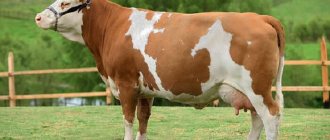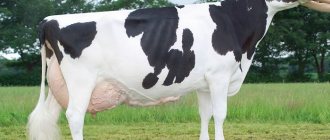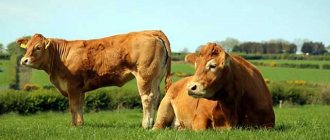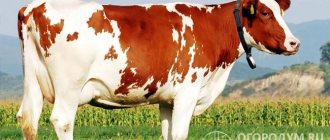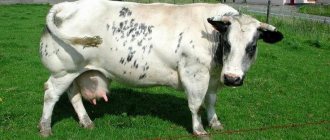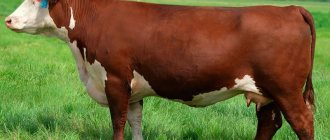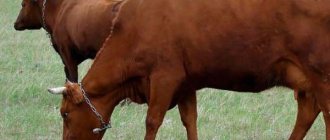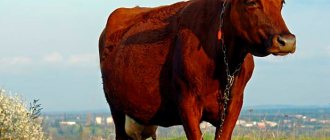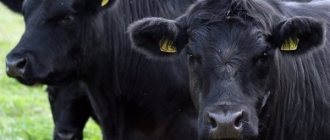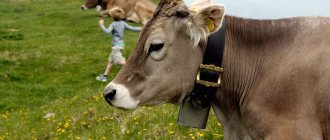History of appearance
Charolais is a breed of cattle bred in France, more precisely, in the French region of Charolais. This event took place in the 18th century.
To obtain the breed, cows of the Highland and Simmental breeds were crossed. Later, in order to improve certain qualities, the already obtained animals were crossed with the Shorthorn breed. The result of this experiment was a new type of cattle that met all consumer requirements.
But the improvement didn't end there. Further, the breed was improved by purebred selection. The emphasis was on the quality characteristics of the meat. We achieved that there were practically no fatty layers in it.
The final type of Charolais was recorded in 1855. Their breeding territory covers Europe, North and South America, and Asia. France already has about 2 million specimens of the Charolais breed. Ukraine actively uses representatives of this individual to improve the qualities of other breeds. Russia started growing Charolais relatively recently. The number of heads is about 1000.
How did you appear?
This is a purely French breed of cattle. The beginning of a new type of cow was laid in the second half of the 19th century in the province of Charolais. It was there that females and males of a beef breed of a completely new constitution first appeared - huge animals with a pile of muscles that looked unusual compared to other, smaller cows.
Subsequently, Charolais cows began to appear in different provinces of France, and were also popular in neighboring countries. The gene pool of this breed is currently derived from Alpine and Swiss Charolais individuals.
They tried to improve this species several times, but by the end of the 19th century, breeders were convinced of the futility of their attempts, and since then they have been bred only by crossing within the breed.
External characteristics
The Charolais breed is famous for its size and impressive muscle mass. The breed of these cows was bred to produce high-quality and tasty meat from animals. The color of Charolais cows is white, milky beige. The color of bulls is darker than that of cows.
Body structure characteristics:
- Small head.
- Short thick neck.
- Broad forehead.
- Strong, wide chest.
- Wide sacrum.
- The spine is slightly concave.
- Legs are straight and powerful.
- The udder of cows is small and regular in shape.
- There are pronounced muscles throughout the body.
- They have straight horns growing to the sides. Hornless cows are sometimes observed.
- The skin is folded in the neck area.
- The coat is thick, sometimes wavy.
The height of cows sometimes exceeds 140 centimeters, length - 170 cm. Bulls reach a height of 160 cm and a length of 200 cm.
The weight of an adult cow ranges from 700 to 1600 kg.
Charolais have their heavy weight due to massive muscles located over the entire surface of the animal’s body.
Productive characteristics of the breed
The weight of adult cows is 900 kg, bulls 1100, slaughter yield up to 65%. Calves are born very large, on average 50 kg. Cattle gain weight quickly.
On a note! During fattening, Charolais develops not fat, but muscle mass.
Charolais cattle are capable of gaining weight even just on pasture grass. But the animals have an excellent appetite and, when fattened on grass, require significant pasture areas. In the absence of fat, the meat of Charolais cattle remains tender and has high taste.
Productivity of Charolais cattle of different ages
| Animal type | Age at slaughter, months | Live weight, kg | Slaughter yield, kg |
| bulls | 15 – 18 | 700 | 420 |
| Heifers | 24 – 36 | more than 600 | more than 350 |
| Full-aged cows | over 36 | 720 | 430 |
| bulls | over 30 | 700 – 770 | 420 – 460 |
Interesting! Directly in the homeland of livestock, in France, bull calves are not fattened for slaughter, but are sold for fattening to Italy and Spain.
French farms receive their main income from the supply of calves aged 8 to 12 months to Italian and Spanish industrialists.
The milk characteristics of Charolais cows are clearly exaggerated. Sometimes you can find data that Charolais cows produce 4 thousand kg of milk per year. But this figure is not always achievable even in meat and dairy breeds. The data indicating the milk yield of cows is 1000 - 1500 kg per year looks more realistic. But even more likely is the fact that no one seriously measured the milk yield of Charolais cows.
Important! A Charolais calf should not be fed artificially.
Charolais calves must remain with their mother for at least 6 months. At the same time, cows have a very well developed maternal instinct. She will not let anyone near the calf and will not give milk to anyone except her calf. In general, no one cares about the milk productivity of Charolais cows. The main thing is that the calf has enough milk and does not lag behind in development.
On a note! Charolais cows often give birth to twins, which is considered by some experts as an advantage of the breed, and by others as a disadvantage.
Charolais productivity
Charolais animals are bred for meat. They quickly build muscle mass. The slaughter yield of animal meat is about 70%.
The advantage of beef is that it does not show signs of aging for a long period of time. In addition, meat does not change its taste as the animals age.
The milk yield of Charolais cows is low. In a year, one cow can produce an average of 2000-2500 liters of milk. But its fat content is 4%. This is a good indicator among representatives of meat breeds.
In addition to meat, Charolais is also used for other purposes. For example, bulls are used for draft purposes. For this purpose, animals up to 14-15 years old are selected. Although in Russia this method of using Charolais is used quite rarely.
Reviews from Charolais owners
It is too early to talk about the opinions of Charolais owners in Russia or Ukraine. In the CIS, the Charolais is still a very exotic breed. But foreigners already have an opinion.
Tom McClain, Ireland
Introduced to the UK from France, Charolais revolutionized our market. Initially, they even wanted to ban the import of these cattle, since British beef cattle breeds were not able to compete with Charolais. Today in the British Isles, Charolais is not only bred pure, but also crossed with other breeds, since Charolais cattle have no equal in its meat qualities.
Oksana Lobova, p. Field
Dairy cows have always been kept. And then with this war they decided, before it was too late, to provide themselves with a source of meat. So in the spring of 2015, while I still had money, I went to our regional innovator, who brought the French breed to Ukraine, and bought a one-year-old heifer from him. Later I had to cover it with an ordinary bull; you can’t mess with a “native” bull. But even so the calves turn out to be “meaty”. So we now have enough meat reserves for the whole year. But we didn’t manage to try milk from Charolais. As soon as he calves, he stops letting him approach him completely.
Advantages and disadvantages
Each breed of cattle has its own advantages and disadvantages. This is what causes the constant search and breeding of new species. Charolais animals have many advantages.
- Quick adaptation to new conditions.
- Intensive growth of young animals.
- Heredity.
- Small food intake with rapid weight gain.
- Adapted to grazing on pastures.
- Tribal qualities.
- Long period of cow productivity (approximately 15 years).
- Minimum fat content in meat.
- Large yield of meat with the additional possibility of obtaining good milk yield.
- Excellent preservation of beef.
But any breed has its drawbacks. Charolais breeders note some external defects in cows, difficult calving due to the large size of calves, and rare infertility of females.
Statistics
• Charolais are well suited for fattening • They have excellent natural live weight gain • Tremendous muscularity • Easy to manage in terms of temperament • Calving ease • Not picky about feed • Charolais are given a clear color code, Charolais calves are predominantly color coded which provides a guarantee their origin
Charolais breed parameters:
1. Height of cows is 1.3–1.55 m, bulls – up to 1.65 m 2. Oblique length of the body reaches 2.2 m 3. Chest girth – from 1.9 m 4. Depth of the chest reaches 80 cm
Charolais cows are used for more than just meat. They provide a high fat content, up to 4.1% in dairy products, the amount of milk is 2.5 tons per year. Very rarely this figure reaches 4 tons. The main type of productivity is meat. Calves are born with a large body weight, from 30 kg. There have been cases of the birth of young animals weighing from 55 to 70 kg. Intensive growth lasts 2 years, weight gain is about 1.0-2.0 kg per day.
The breed shows dimorphism: cows are smaller than bulls. Typically the weight ranges from 1000 to 1600 kg, although some bulls can reach up to 2000 kg. For a Charolais cow, the normal weight is 600-750 kg, but there are cases when they gain over 800 kg. The meat yield is 65%.
Maintenance and care
Charolais cows are distinguished by their endurance. They quickly get used to climate change. But due to the almost complete absence of fat in the body, they do not live in the cold. Low temperatures can kill the animal. There is a need to create greenhouse conditions for them.
- The housing for Charolais cows should be warm, dry and spacious.
- The cow and calf should be housed separately from the rest of the herd.
- It is necessary to arrange a place for grazing. This guarantees an increase in muscle mass (Charolais can grow even when consuming only green grass). In addition, exposure to air strengthens the animal's immunity.
- The stall must be kept orderly and clean.
- Requires 2 feeders - for dry food and for water. It is desirable that they are removable. This makes them easier to wash.
- The floor must have a urine drain.
In the summer grazing area, a canopy should be equipped that will shelter the cows from rain and sun. In the cold season, Charolais is made of straw flooring approximately 50 centimeters thick. Straw is added periodically.
Main advantages of the breed
Very often, in order to obtain good performance indicators in terms of weight gain, beef cattle have to be fed expensive concentrates in large quantities. With the Charolais cow breed the situation is a little different. One of the undoubted advantages of such bulls is that they can gain a lot of weight on roughage - on hay and grass.
The advantages of this breed in comparison with some others include very tasty, juicy marbled meat. Charolais cattle, like many other French bulls, usually contain little fat. The yield of muscle mass in a cattle carcass of this breed in most cases is at least 80%.
The ability to quickly acclimatize to almost any corner of the planet is what, among other things, distinguishes these cows. The description of the Charolais breed given above allows us to judge it as one of the best meat breeds today. Indeed, such bulls can be considered perhaps the largest in the world. At the same time, cattle of this breed can be raised in almost any country - both southern and northern. In cold climates, cattle of this breed grow thick hair.
Among the advantages of this breed, many farmers include the possibility of successful crossing with other cattle. Half-bred calves from these cows are often in no way inferior to their parents in terms of productivity.
Living conditions
For Charolais cows, normal air temperature is important, otherwise the animal may get sick and die. The optimal temperature is from 10 to 20 degrees. In extreme heat, animals lose weight. Therefore, it is important to ensure ventilation of the room and prevent drafts.
The barn needs to be cleaned regularly. In winter, this must be done daily, and in summer, when cows spend most of their time on pasture, cleaning can be done once a week. It is important to keep not only the floor in order, but also the feeders and drinking bowls.
Features of the content.
In warm climates, with good pastures, Charolais cattle do not cause any trouble.
out to pasture
In cold regions, for the winter you will not only have to stock up on a large amount of feed, but also provide the animals with a warm room, since in the cold and draft they get sick and die. It is also necessary to have an experienced veterinarian who will not only assist with calving and perform general veterinary procedures, but also, if necessary, perform a caesarean section. Another factor is the need for dehorning, since the cattle are not polled, but aggressive.
on the walking area
Nutrition
Charolais is one of the cattle breeds that are unpretentious in feeding. In summer, these animals are able to live entirely on damp grass and water. At the same time, they provide an increase in meat and muscle. But to obtain a larger animal with good quality characteristics of milk and meat, it is necessary to provide a complete, balanced diet.
Important! It is necessary to satisfy the cows' need for salt. It is placed directly in the stall in the form of a lick block.
Lack of water in hot weather will provoke outbreaks of anxiety and irritability in Charolais. Therefore, you need to ensure that there is always water in the drinking bowls, and that there is a pond next to the pasture.
In winter, Charolais cows need to be given feed and hay. They are mixed in feeders or given separately. Dairy cows are supposed to be given concentrates and grain at the rate of 500 grams per 1 centner of animal weight, about 10 kilograms of silage, less than half a kilogram of molasses per day in addition to the main feed - hay.
Peculiarities
Of course, like any other beef cattle, Charolais cows and bulls are distinguished primarily by their large size and weight. The chest girth behind the shoulder blades of these animals can reach 200-210 cm. The bones of cattle of this breed are very powerful and strong.
Also distinctive features of Charolais cattle are:
- powerful wide lower back;
- rectangular body;
- strongly defined muscles, especially on the chest and thighs;
- small flat head;
- thick short limbs;
- big eyes.
In most cases, Charolais cows are horned. However, polled individuals can sometimes be found in the herd. The color of such cows is usually light cream. Such cattle look quite unusual. Photos of Charolais cows presented in this article demonstrate this clearly. The light color of the Charolais is complemented by a soft pink nose and waxy horns and hooves.
The height of a cow of this breed can reach up to 165 cm at the withers. But in the Russian climate, this figure for Charolais usually still does not exceed 145 cm. The body length of bulls of this breed can reach 190-220 cm. For queens, this figure is 165-182 cm.
Health
If you monitor the living conditions and keeping of animals, and prevent drafts, then diseases will not bother the cows and their owners. But this can still happen. Main problems:
- Due to the large weight, animals develop leg diseases.
- Charolais cows rarely experience infertility.
- Charolais cows have a difficult time giving birth due to their large calves.
- Calves are often born with heart failure.
To improve your health, you need to regularly invite a veterinarian for examination and get vaccinations on time. Inspections by the owner of the animals also play a significant role. With constant monitoring of the skin, teeth and hooves, you can detect the problem much earlier and take measures to eliminate it.
Description of the cow
Impressiveness and simultaneous attractiveness are the main features of these white cows. The head is small in size with a wide forehead on a short thick neck, the nose area is also light. The chest is large, plump, strong, with a pile of muscles. The back is slightly concave, the sacrum is wide and straight, the height at the withers is 1.3–1.35 m, the total length is 1.7 m. The size of males is much larger than that of females, and their muscles look especially impressive.
Charolais cow
The limbs of this cattle are straight, medium in size, and powerful. During the fattening process, animals gain muscle mass, but fat practically does not increase. The weight of an adult bull reaches 1.2 tons, a cow weighs on average up to 0.7 tons. Newborn male calves weigh 44–45 kg, and heifers weigh 40–42 kg at birth.
Childbirth and calf
Difficult birth is one of the disadvantages of Charolais cows. Pregnancy proceeds without problems. The calves born to such cows are large - their weight can reach 60 kilograms. This causes complications during calving. It is difficult for a cow to cope on its own, so a person has to intervene. Otherwise, the female or calf will be harmed. The survival rate of calves born from Charolais is approximately 92%, and only 90% survive to six months.
Born calves are fed with the mother's milk until 8-9 months. It is not recommended to switch them to roughage, as this is fraught with a painful reaction in the calves. This is done only if the cow does not have enough milk, or she cannot feed the calf for some other reason.
By 8 months, the weight of young animals averages 300 kilograms, and at 1.5 years - 600 kg. This depends on the sex of the animal and the availability of food. Females gain weight more slowly than bulls. Active growth is observed until the age of two. Then the rate of weight gain decreases. Calves have wavy, thick and uniform coat.
Characteristics of Charolais cows
The Charolais cow breed belongs to the meat category. It is for the sake of obtaining quality meat that they are bred by farmers around the world. Below are the main characteristics of the species and its distinctive features.
- The meat of this breed is very tender, tasty, and lean.
- Slaughter yield of meat is 60-70%.
Important!
The main advantage for which the Charolais breed is valued is the absence of signs of aging of the meat, regardless of the date of slaughter of the animal!
- The cow's milk production is 1700-1900 kg. Record figures – 2500 kg.
- Milk with fat content up to 4.1%.
- The animals are hardy and develop correctly. Intensive growth of calves continues until 2 years of age, and then the rate of development decreases.
- Calving is the negative side of the breed. During birth, cows need professional help.
- Newborn calves can have inherited diseases such as heart failure.
- Animal productivity is maintained for 15 years.
After birth, calves are left with their mother for 8-9 months
The character of the Charolais cow breed can be aggressive, especially in females nursing calves. In some cases, these massive animals can be dangerous to humans, so you need to know how to handle them.
Charolais character
The impressive size of Charolais scares many. But animals of this breed are distinguished by a calm, self-possessed character. Although sometimes they can be aggressive. This is especially true for females nursing their calves. While protecting the young, the animal can become dangerous to other individuals and humans. Outbursts of aggression will occur when fighting for water and food. Therefore, you need to adapt to communicating with Charolais.
Important! Females of this breed look after their calves, protect and protect them.
Description of the breed
The color of animals of the Charolais breed is light. Bulls are darker. Their coat color is closer to a fawn shade. Calves are born snow-white, with long hair that curls all over the body. The physique of the animals is compact, muscular, strong. They have a wide, flat back, strong but short limbs. The neck is massive and short. Bulls have a hump on their necks.
Numerous folds of skin hang down on the chest. The chest is wide: girth 200 cm. The animals have a large head and a wide forehead. The sides are barrel-shaped. Charolais individuals have thin skin. Powerful muscles are visible through it.
- The height of a Charolais bull at the withers is 165 cm, for cows it is 150-155 cm.
- Calves are born with a large weight: bulls - 45 kg, heifers - 38-40 kg. Charolais cows inherited twin pregnancies from the Simmental breed. 4% of the total cow population gives birth to twins.
- The milking age of calves ends at 8 months, but already from 2 months hay and green grass begin to be introduced into the diet of young animals. A calf gains weight of 1400 g per day. At 15-18 months, live weight reaches 600 kg. The calves are placed for rearing. The period lasts 3 months. The bulls gain more than 800 g per day. The bulls are slaughtered at the age of 18-21 months. At this time, the weight of the animal reaches 900 kg. During fattening, bull calves do not accumulate fat. The main part of the feed is used to increase muscle mass.
- The weight of an adult bull is 1200 kg, a cow weighs less - 900 kg. Slaughter yield 65%. The meat is soft and juicy. Experts note high taste qualities.
- The Charolais breed of cows produces 2 tons of milk during lactation. This is a good indicator for a beef cattle breed. Fat content even in summer is 4%.
- The udder is average. The volume is small. The mammary gland is taut and has good attachment. The teats are long and suitable for machine milking.
- Animals love a humid, mild climate and clean air. Under such conditions they do not get sick.
- In order for the livestock to show good productivity, they are prescribed a certain diet. Experts note the effectiveness of using feed.
A farmer may purchase polled stock, but Charolais animals have horns. The offspring of polled cows and bulls will have horns. Polledness is achieved artificially.
The animals are large in size, but they are calm and do not show aggression towards people. There is no need to rid the animals of their horns, especially since they are small in Charolais.
Breeding Charolais
The offspring of Charolais cows inherit all the qualities from their parents. Therefore, there are no problems with breeding. If there is a bull and a Charolais female on the farm, you can safely breed them and breed offspring. Grown-up individuals pass on the inherited qualities to the next generations. This can continue as long as the breeder needs.
The French Charolais breed is quite young compared to other cattle breeds, but has already gained popularity among breeders. Considering the size and character of the animals, we can conclude that Charolais are suitable for breeding in small groups and in medium-sized farms. With proper care and proper housing conditions, cows will reward their owners with lean beef and fatty milk, albeit in small quantities. Therefore, raising Charolais cattle is an excellent option for farmers with experience handling cattle.
Breeding Charolais cows from scratch
We recommend reading our other articles
- Description of the Rinda cabbage variety, planting and care in open ground
- How to properly prepare raspberries for winter
- How to hatch goslings in an incubator
- Crop production
Charolais cows have good heredity. Thanks to this, problems usually do not arise in terms of breeding and obtaining breeding offspring. All a novice breeder needs is to purchase a purebred cow and a bull, from which the next generation will come. Young animals receive from their parents all the qualities inherent in the breed, and in the future they will be able to pass them on to their offspring.
Important!
The safety of calves at birth is no more than 92%, and no more than 90% survive to 6 months.
However, the main disadvantage of the breed is associated with the breeding of these animals, namely calving. A cow is able to carry a baby, especially if she is provided with adequate feeding and warmth, but with calving everything is not so pleasant. Calves are born quite large and can reach a weight of 65 kg, so it is difficult for the female to cope on her own. Only with the professional help of a veterinarian can childbirth occur without significant problems. Otherwise, the female or cub may be harmed.
After birth, calves are left with their mother for 8-9 months. She is the one who must feed them. Unlike many other species, this breed should not be transferred to artificial feeding, because the calves may begin to get sick. Only supplementary feeding is allowed if the female has little milk or for other reasons.
Charolais in the pasture
How much does a calf cost?
Such cattle have earned good reviews from domestic homestead owners. But Charolais in Russia, as already mentioned, is not a very common breed. Private owners have the opportunity to buy such a calf. But young Charolais in our country, unfortunately, is quite expensive. The price for a calf is in most cases at least 30 thousand rubles. The cost of breeding bulls of this breed can reach up to 90-100 thousand rubles.
Read more: Homemade lemon diseases: causes affecting leaves and treatment
In addition, since there are no Charolais breeding farms in Russia, the owner of a farmstead always runs the risk of acquiring a half-breed. Perhaps such a bull will subsequently gain a lot of weight. But still, it will no longer be Charolais.
Diet
In summer, the livestock is kept on pasture. The herd is taken to the pens at sunset. The pens are made open, with a canopy. Bedding is laid on the ground. In addition to meadow grass, in summer the animals are fed hay at the rate of 1 kg per 1 kg of animal weight. During milking, cows are given concentrates and a grain mixture: 500 g per 1 centner of weight.
Read more: Mixture of nectarine and apricot hybrid, what is the name of the photo
For bulls, combined feed is distributed into feeders. The mixture is given together with hay or separately. Pasture is chosen near a watering place. If it is an erik or a lake, then the water must be analyzed for pathogens of infectious diseases.
In winter, the herd is housed in a barn. Despite the fact that the animals have long hair, they cannot tolerate frost. You can walk them in the pen. If the temperature is not lower than 20 degrees. The duration of the walk is no more than 2 hours. During this time, the operators will have time to clean the stalls and lay down fresh bedding.
The temperature in the barn should not be lower than 15 C. The room is ventilated. If necessary, install forced ventilation in it. With a high content of ammonia and carbon dioxide in the air, animals begin to get sick. They develop upper respiratory tract diseases.
Winter feeding differs from summer feeding. The bulls are put into fattening. For them, the silage method is used.
https://www.youtube.com/watch?v=subscribe_widget
For bulls, the following feeding scheme is described:
- 1 month – silage 30 kg, straw 3 kg, concentrates 1.5 kg, salt 30 g;
- 2 month – silage 25 kg, straw 2 kg, hay 1 kg, concentrates 1.6 kg, salt 35 g;
- 3 month – silage 20 kg, straw 1 kg, hay 2 kg, concentrates 1.9 kg, salt 35 g.
More on the topic:
Features of the structure of the milking machine for cows
| № | Helpful information |
| 1 | 3 kg of hay and straw |
| 2 | 11 kg haylage |
| 3 | 10 kg corn silage |
| 4 | 1.5 kg concentrates |
| 5 | 300 g molasses |
| 6 | 50 g premix |
The diet is designed for a cow weighing 600 kg. It is used in the first half of the lactation period. Next, the diet is adjusted. If milk yield is stable, the feeding scheme is left. When productivity decreases, the amount of feed is reduced.
Animals of the Charolais breed have good characteristics. In addition to high meat and dairy productivity, their unpretentiousness in food is noted. Of course, they should not be given rotten, spoiled or dirty food, but it is quite possible to change the types of food. Instead of part of the silage, they sometimes give vegetables, instead of combined feed, a grain mixture. Animals will eat everything. Changing feed will not affect productivity.
Heading Cattle farm Charolais bulls Viewing time 2:50 Heading Charolais cows. Went AWOL.Watching time1:07Title Charolais breed.Watching time1:11
The unpretentiousness of Charolais cows also extends to their eating habits. For good weight gain, regular feeding with oats or straw is enough for them - cows agree to any food and easily digest it. In summer, spending on food can be completely limited - high-quality grass will be enough for cows to eat and gain good body weight.
The choice of feed does not affect weight gain; weight is steadily gained during the first two years of the calves’ life. When raising a bull for slaughter, it is enough to fatten it for 2-3 months, but adult animals will also be useful on the farm.
Charolais cows are unpretentious eaters
What to feed
This breed is unpretentious to feed and gives good growth even on hay. To achieve high performance, optimal feeding should be ensured. In summer, grazing is necessary. To ensure that the body receives the necessary substances, a special salt lick is installed in the barn.
Summer grazing on a pasture
Charolais cows are unpretentious in care, and even in the cold season, cows and bulls can be walked. These animals are unpretentious in terms of nutrition - any cattle feed is suitable for them. In warm weather they prefer grazing on pastures. The basis of nutrition during this period is meadow grasses, leaves and twigs of shrubs.
Approximate cow diet:
- roughage. They make up the bulk of the entire diet (more than 50%). These are hay, straw, grass, husks and husks;
- stabilizing to replenish energy (vegetables);
- compound feed (not given to cows).
In addition to meadow grass, in the summer cows are given hay based on the proportion of 1 kg to 1 quintal of body weight. During the milking period, cows are given a mixture of grain feed, following the norm - 0.5 kg per 1 kg of weight. To gain weight, bulls are given 1–2 kg of commercial feed per day, which is distributed among feeders.
As a top dressing, you can give compound feed, sunflower cake, vegetables (beets, carrots, turnips, potatoes, etc.). It should be noted that potatoes are a good prevention of bloating for cattle and should be given in early spring.
Feeding diet in winter
In winter, cows are given hay and silage instead of fresh grass. During this period, bulls are fed for fattening using the silage method. Silage contains grass, vegetables, corn, and sunflower. Root vegetables are perfect for feeding.
In winter, cows' bodies need essential vitamins and minerals. To ensure their inclusion in the diet, special fortified supplements are introduced and mixed into the feed. Considering that cows calve in the winter, they need to ensure that their babies receive chalk, bone meal and other elements during the feeding period for lactation.
It should be noted that food waste in the form of vegetable peelings (especially potatoes) with the addition of bread crumbs is a good supplement for weight gain and significantly saves money.
Water
When grazing in summer, they try to choose pasture near water sources, but water must be taken for analysis. If it is not suitable for drinking, then the herd is driven away from such a source of drinking. In this case, the herd is watered in the morning before grazing and before milking in the middle of the day. Cows must be provided with plenty of water.
Did you know? Each adult cattle produces approximately 10 tons of feces per year. Since rotted cow manure is an excellent fertilizer, it makes sense for cattle farmers to build a dung farm on their farm.
The water should be warm and clean. In the warm season, up to 60 liters of drinking water per head is required, and in the cold season - up to 40 liters. The preferred water temperature is 16–17 °C. During the cold period, the drink is heated to the required degree.
It’s not for nothing that Charolais holds the record for high-quality meat products, even from older animals. With all this, cows of this breed are still capable of producing considerable amounts of milk, as for representatives of the meat industry. They often have difficulties during reproduction due to the large size of the calves - they often have to use a cesarean section, so it is better to invite a veterinarian to the birth. This unpretentious breed in mild climates can be kept simply in a paddock with sheds and left to pasture in the summer.
Tips and tricks for farmers
Experienced farmers advise when raising Charolais cows to carefully ensure that the purity of the breed is maintained. Inbreeding is not allowed, so the bull for coverage must be taken from a completely different line. You can purchase a high-quality bull bull once every 2-3 years.
When crossing purebred Charolais bulls with dairy and combined breeds, you can get good results. Crossbred heifers have intensive growth and high-quality meat.
In the video you can see young Charolais bulls being fattened.
Origin story
The history of breeding Charolais cows dates back more than one century, because animals first appeared in France at the beginning of the 17th century. The ancestors of modern Charolais cows are considered to be local varieties with different levels of productivity and exterior features.
At the official level, the new breed was recognized only in 1864, when the first breed books began to be created.
True, it should be noted that the first Charolais cows were significantly different from modern representatives of the breed, and successfully combined meat and dairy productivity, not to mention good traction qualities (for a long time bulls were kept specifically for physical work).
Despite the fact that in those days the weight and muscle development of animals were somewhat inferior to modern values, strong immunity and endurance fully compensated for this.
Scientists moved to new breeding plans to improve the breed only at the beginning of the twentieth century, when existing cattle in the province of Charols began to be crossed with the Shortgon breed and Simmentals.
Did you know? Cows of the Charolais breed were very actively crossed with Brahmans, and the breeding work was carried out so intensively that a new cross has already appeared in Australia - thyme. It is very difficult to get such an animal, because in order to get into the stud book, it must have 75% Charolais blood and only 25% Brahman blood.
From that moment on, the emerging generation began to be selected based on the height and total weight of the animals, and after the war, the first breeding enterprises, technical centers and even the breed’s own federation appeared. Charolais entered the territory of Russia and Ukraine only at the beginning of the 2000s and is still rarely found.
